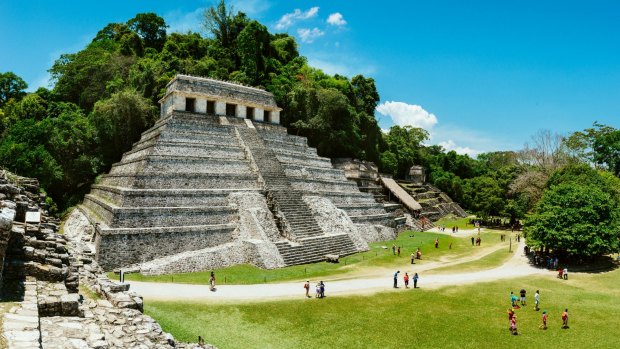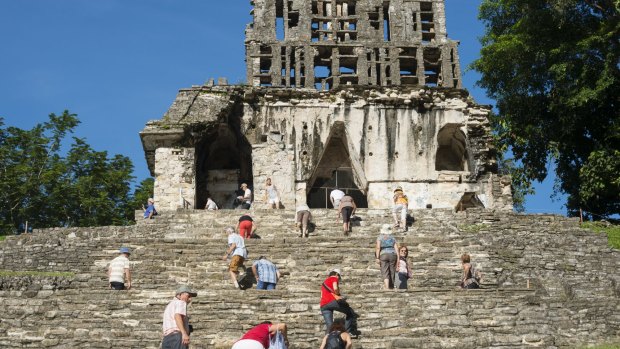This was published 4 years ago
Maya city of Palenque, Mexico: Visit the archaeological site where the world was supposed to end
By Alison Stewart

The magical Maya city of Palenque.Credit: iStock
This still, green jungle is awe-inspiring and vaguely terrifying. There's a temptation to walk quietly, whisper. It seems to possess knowledge and power far greater than ours. At its centre is the magical Maya city of Palenque, wreathed with doomsday conspiracy theories, witness to an ancient, erudite culture.
While Europe endured its Dark Ages, the Maya were excelling as a civilisation, practising astronomy, developing an intricate number system, building sophisticated pyramids using advanced engineering and architectural methods, decorating them with artworks of style and complexity.
The intricacy of their calendar and culture spawned a New Age mysticism called Mayanism, prompting thousands of adherents to converge on Palenque and other Maya sites on December 21, 2012. They believed this number – the end date of a 5126-year-long cycle in the Mesoamerican long count calendar - heralded a cataclysmic event.

Visitors clamber up the Templo del Sol in Palenque.Credit: iStock
It was thought that Armageddon was nigh, though there was nothing in Mayan literature to suggest this. At Palenque, they set up a great rainbow circle "hum", milled around then went home when nothing happened.
We may scoff but there is indeed something eerie about these pyramids and limestone monuments in the Chiapas jungle, which is still one moment, the next, shuddering with the guttural laments of howler monkeys.
Palenque's ruins – including the Temple of Inscriptions, Temple of the Cross group, Red Queen and Skull and the Palace complex - are enormous and yet they amount to only a fraction of a powerful Maya city, once called Lakamha, place of great waters.
About 1400 documented structures are scattered through 1780 hectares of ravenous jungle. More than 90 per cent of Palenque is yet to be excavated. With annual average rainfall of four metres, untended buildings are quickly overtaken by jungle. The giant pyramids, now world heritage-listed, were once covered with red and blue-painted stucco, glowing like jewels in the jungle.
We have made the arduous road trip from the "Pueblo Magico" (magical village) Maya town of San Cristobel in Mexico's central highlands to Palenque in the lush basin of Chiapas's Usumacinta River. The city was once capital of a powerful Maya dynasty that ruled swathes of what are today the states of Chiapas and Tabasco. It's been a 4am start to avoid the revolutionary Zapatista's roadblocks.
Palenque is one of Mesoamerica's most important archaeological sites, dating from 226BC to 900AD. Its treasures – the finest architecture, sculptures, frescoes and carvings the Maya produced – hold the key to an advanced civilisation about which we are still learning. Most valuable of all, the Maya glyphic inscriptions have allowed archaeologists to unlock mysteries of the Maya dynasties, their belief systems and culture.
A Spaniard, Father Pedro Lorenzo de la Nada first came upon the stone city in 1567. He named it Palenque, meaning fortification in Spanish. But it was Mexican archaeologist Alberto Ruz Lhuillier who discovered the burial tomb of the Maya king, Pakal the Great in 1952 – the American equivalent of Tutankhamun's tomb.
This began the process of understanding the world of the ancient Maya. Other royal and noble tombs have been discovered though archaeologists still search for the tomb of Pakal the Great's son, K'inich Kan Bahlam.
We have already seen the recreated sarcophagus of the late classic Maya King Pakal in Mexico City's National Museum of Anthropology, containing the king himself and his striking jade funerary mask with shell, mother of pearl and obsidian eyes. His clubfoot was possibly the product of incest practised by the Maya to protect the royal line.
The original, elaborately carved sarcophagus, built before the stepped pyramid was constructed and weighing 22 tonnes, remains inside the Temple of Inscriptions. To prevent the collapse of the tomb due to the pyramid's immense weight, Maya architects built a sophisticated hut-shaped chamber using cross vaulting and recessed buttresses. The temple's interior panels bearing the glyphic are now 70 per cent deciphered, yielding valuable information about this important figure.
The sarcophagus fed the frenzy of Mayanism with hypotheses that ancient astronauts, welcomed as gods, imparted the knowledge of ancient civilisations.
In 1968, Erich von Daniken's bestseller Chariots of the Gods? presented Pakal as one of these ancient astronauts deified by the Maya. Others were pretty sure that Pakal's sarcophagus was a spaceship.
Our excellent guide, Francisco Anaya, takes us into the Palace complex, one of the most complex Maya architectural structures. This was a royal residence and court, richly decorated. Set on a 10-metre platform, there are internal courtyards and galleries with vaulted ceilings and a square, four-storey tower.
The city's water system deployed advanced hydraulic engineering to enable water to reach the palace upper level. We are fortunate to visit – Francisco tells us the palace will soon close to the public. Palenque is evidence of both our human frailty and our determination to survive.
TRIP NOTES
TOUR
Intrepid Travel's 15-day Best of Mexico trip starts in Mexico City and ends in Playa del Carmen and includes accommodation, transport, most meals and activities, and an expert local guide. From $3770 per person, twin share. Phone 1300 458 437, see intrepidtravel.com/au
FLY
Qantas flies daily from Sydney to Mexico City via Dallas (includes an American Airlines codeshare) and Cancun to Sydney via Dallas. See qantas.com
MORE
Sign up for the Traveller Deals newsletter
Get exclusive travel deals delivered straight to your inbox. Sign up now.